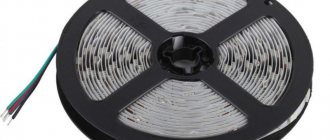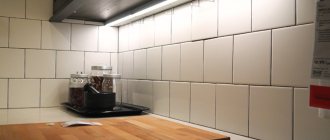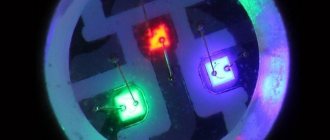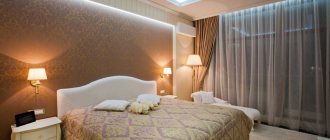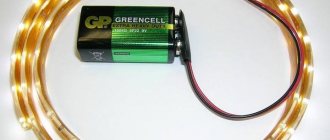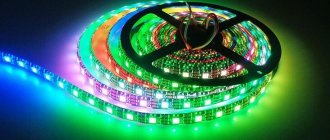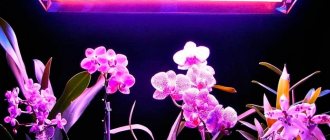Light color: SMD, RGB…
Each type of LED strip is created for its own purposes. Essentially there are two of them: lighting or decorative lighting. Depending on the purpose, ribbons of different colors are used:
Single-color (SMD) - usually used to highlight certain areas in an apartment or house, highlight furniture, door or window openings. The most popular color is, of course, white.
Multicolor (RGB) - for decorative illumination of objects or surfaces.
It should be noted that multi-color LED strips often have a remote control with which the lighting intensity and “color” can be changed. If there is not enough sun in your apartment, you can set a pleasant yellowish light, if guests come and you want to have fun, turn it bright blue or green.
Single-color white glow strips can actually also have different color temperatures. It all depends on the characteristics of the LEDs used. Most often, such tapes are oriented towards cold light (4000K and above). If you want warm, you'll have to look harder.
LED strips
For lighting and decorative lighting, different lengths and power
Buy
How to choose a high-quality LED strip for RGB lighting
The choice of RGB backlight is determined by several criteria:
- working conditions;
- dimensions and configuration of the surface to be designed;
- expected light level;
- power, supply voltage.
Comparison of these parameters allows you to select the most suitable LED backlight. In addition to the above indicators, it is important to choose among well-known and reliable manufacturers, since cheap products from developing countries are not able to demonstrate high-quality and durable performance.
If there is any doubt about the origin of the tape, it is better to look in another store. This will take some time, but it will help you choose the optimal and high-quality RGB backlight option for the existing conditions.
Supply voltage and power
LED strips can be sold with or without a power supply. In the latter case, you will have to purchase an additional unit. How to choose a power supply for LED strip?
First, we determine the supply voltage - it can be either 220, 24 or 12 V (12 volts are the most popular). Then we calculate the required power. To do this, we need to know the specific power of one meter of tape - it is usually indicated on the packaging. Let's multiply this figure by the number of meters, add the necessary power reserve (at least 20%), and the calculation is ready.
For example, you decide to install an LED strip with SMD3528 LEDs (with a density of 60 pcs per meter), the power of one meter will be equal to 4.8 W/m. A five-meter piece of tape will require a 24 W power supply, but, as we noted, a power reserve of 20% is needed. Therefore, a 30 W power supply is suitable for such a tape. A similar approach to calculations is suitable for all types of LED strips.
What is RGB backlighting
The abbreviation RGB stands for Red-Green-Blue, which in Russian means Red-Green-Blue. LED strips of this type contain three types of LED elements, in which a certain combination of glow modes allows you to create any color combination. RGB tape can also glow white, but in practice such lighting always has some shade of one of the basic colors.
For lighting engineers this is a disadvantage, but designers, on the contrary, consider this feature an advantage. If you need to get pure white, use a special type of tape, which is designated RGB+W (+White, with additional white color). As a rule, such strips are double-row and represent a combination of a regular monochrome white LED strip and an RGB lamp.
Modulation of the glow shade occurs by increasing the intensity of one of the base colors. If everyone lights up in maximum mode, then the entire tape will end up glowing white (with certain corrections). Both options - RGB and RGB+W - are controlled by a special microcomputer (controller), equipped with a remote control for easy color mode changing.
LED strip for indoor or outdoor use
Now we come to the question of where exactly you will install the LED strip, and, therefore, let’s talk about the degrees of protection.
It is logical that if you are going to organize the lighting of the room, you do not need protection as such (unless, of course, it is a bathroom). But for use on the porch or other surfaces outside the house, protection from water is necessary.
There are 3 types of LED strips - regular, silicone and hidden in a PVC tube. If you want to install lighting in a closet, on shelves or in the ceiling, then feel free to choose the simplest, first option. The second and third are ideal for illuminating the street and rooms where there is a possibility of moisture getting on the tape. The difference between these types is rather purely visual: the silicone one looks neater. By the way, choose power supplies according to the same principle. For your home, you can purchase a unit with IP20 certification, and for outdoor use, you can purchase it with IP65 certification and higher.
Also, last but not least, you should pay attention to the manufacturer. If you have the opportunity to choose a tape based on this criterion, then look for products from Gauss or Elektrostandart . The quality will correspond to the price, so their tapes will cost more than their analogues. If you want to save money, you can even buy LED strip from Chinese manufacturers MAXUS or Feron .
Also pay attention to how flexible the base of the tape is. If it bends too easily, the conductive paths may be too thin and the product will have a short lifespan.
LED strip "Economy"
Description. Service life 3-6 months. Loses brightness quickly. LEDs often burn out. The tape is weak and comes off easily. The light is unpleasant, there is no joy from it. NOT suitable for ceiling lighting (that's why we don't have economy class LED strips).
How to recognize? Low cost (50 - 100 rubles/meter). There is no manufacturer's name on the packaging or on the tape. And she herself is thin, like a rag.
Important! In our workshop, ready-made kits, tapes and Economy class components are NOT used. |
Choosing an LED strip according to the installation location
At the end of our review, we have some tips on which tape is best to choose for each room in your apartment or house.
To decorate rooms, an inexpensive white LED strip without moisture protection is better suited. Do not overdo it with power (luminous flux) if you organize background lighting, otherwise the bright light will hit your eyes.
For kitchen lighting, ideally you need a strip with a silicone coating. Where there is a kitchen, there is moisture, so protection will definitely not be superfluous.
For installation in the bedroom, you can buy a multi-color RGB strip. Another possible option is to choose an adjustable ceiling lighting strip. This way you can dim the light or brighten it when needed.
to illuminate the bathroom with silicone-coated LED strip. Don't forget to take care of protecting the power supply, as well as the controller (if used)! The brightest LED strips will be superfluous here - take more modest ones.
In addition to static lighting, you can use controllers to organize dynamic scenarios. For example, organize a “running wave” like this.
LED strip "Lux"
Description. Compared to the Standard tape, the light is much more pleasant. Brighter, more saturated, diffuses well and spreads softly across the ceiling. I just want to sit on the couch and admire this beauty.
Rice. 5. The tape perfectly blends base colors and produces soft shades |
In addition to the basic colors (red, blue, green), the tape perfectly conveys halftones (pink, orange, yellow, blue, etc.). Due to good mixing, the colors are rich and rich.
| From personal experience. We ordered two sets. “Standard” for the bedroom, “Lux” for the living room. They installed the Standard - oh, what a beauty! Lux installed. Hmm... My wife looked and compared. I forced my husband to remove the Standard and replace it with Lux. He had to order another set. Conclusion: anyone who has seen the Lux tapes will not agree to others. The difference is obvious. |
The most important! There is candle light (very pleasant, everyone likes it). For this reason alone it is worth purchasing it. Remember how, when you were a child, sometimes the lights would be turned off and your parents would light candles. There was something magical about it... Ordinary LED strips either have no candle shade or are pale and not so atmospheric.
Rice. 6. Absolutely everyone likes the “Candle” mode |
In white lighting mode, the light is really white, there is almost no blue (in conventional tapes, instead of white light, there is blue). Service life 10 years.
Rice. 7. Packaging of Luxury LED strips |
How to recognize? The packaging looks premium. Manufacturer indicated. Inside there is a passport in Russian. The name contains the word "Lux". 2 year warranty. The tape is thick, the wires are thick. There is a BIN color code on the packaging and on the tape.
White Light Mode
All multicolor ribbons have a white lighting mode. However, the light is not pure white, but a mixture of red, blue and green. Because of this, it has a bluish tint. Here is a photo where we compared the white light from different LED strips.
Rice. 8. Comparison of LED strips in white lighting mode |
Multicolor Standard in white mode has a blue tint. Luxury is almost white. But she is significantly inferior to White Lux. White tape provides light that is closest to natural sunlight. In this light it is comfortable to read, write, and do business.
Conclusion:
For multi-color ceiling lighting, it is better to use a luxury LED RGB strip SMD 5060 - 30 LED (60 LED). Because:
- Service life 10 years
- Produces 60 pleasant shades and midtones
- Has candle light (everyone likes it)
- In white light mode, the light is almost white
- Causes joy and improves mood
How to check the quality of LED strip?
If you've ever tried to choose an LED strip, you've probably noticed their abundance in Asian online stores. Unfortunately, among these offers there are a lot of low-quality products, problems with which can begin within six months or a year. Unfortunately, you won’t be able to draw conclusions about the quality based on appearance, unless the clumsy soldering of the LEDs themselves gives themselves away. If you choose a ribbon in a store, try not to choose a very thin one.
The same brightness and temperature of the glow at different ends of the tape can be considered a unique indicator of quality. But to check this, you need to tinker with the connection.
Where is it used?
The use of linear LED lamps has become widespread and is found in many areas of human activity. The main focus is design:
- interior design;
- decoration of building facades;
- illumination of areas, landscape design elements;
- design of gaming keyboards;
- illumination of vehicle interiors and exterior elements;
- decoration of shop windows, stands, various panels and boxes
- Waterproof types of RGB lighting are installed in swimming pools, saunas and other wet areas.
Interesting! Most often, RGB lighting is found in the design of nightclubs, restaurants, cafes or bars, successfully replacing expensive and fragile neon display cases. In addition, the so-called floating lighting of furniture or cars has become very popular, when an LED strip is attached under the lower plane in such a way that only a reflection on the floor is visible from the outside. A similar effect, only in the opposite direction, is created by secretly illuminating plasterboard ceiling structures.
Special gaming computer keyboards with RGB backlighting have become popular among gamers. They are equipped with various types of mechanical switches like the Cherry Blue Switch or their equivalents. The main purpose of such backlighting is to decorate the keyboard, but users note the ease of use in dark rooms and the ability to change the lighting mode in different situations or conditions.

